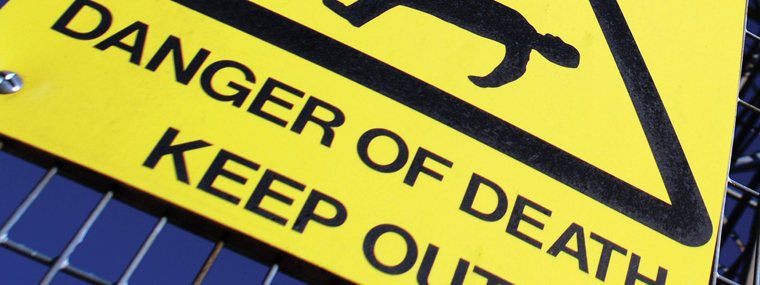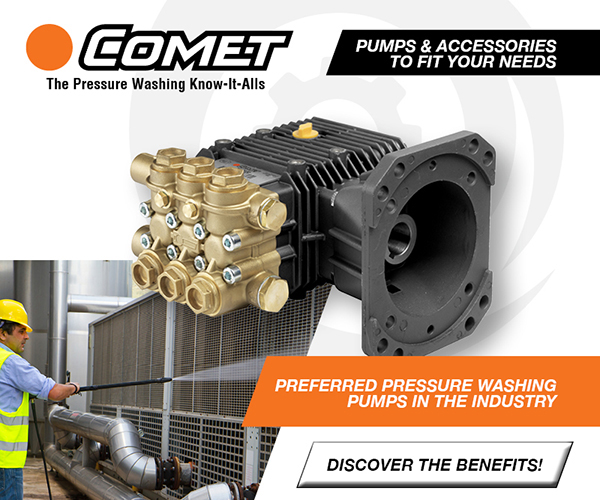
Pressure Washer’s Guidebook: Safety: An Integral Part of the Work Process
Contributor: Roy G. Chappell, CEO, Chappell Supply and Equipment, Oklahoma City, OK / Published July 2015

Editor’s Note: This chapter is a revision of a chapter in the 2002 Power Washer’s Guidebook, “A Power-washer’s Safety Checklist,” which was written by Judith E. A. Perkinson and Gary W. DeHart, The Calumet Group, Inc. Hammond, IN.
Safety First
An experienced power washer begins each job with a review of what must be done. Equipment, job specifications, materials, and procedures make up half the picture. Safety makes up the other half.
No one wants to get hurt on a job. And yet, at the beginning of October 2014 when the Occupational Safety and Health Administration (OSHA) published its top 10 safety violations for the fiscal year 2014, there were thousands of citations each for the top 10 safety violations. Fall protection ranked first among violations with 6,143 citations. [See the October 6, 2014 issue of Safety Compliance Alert at www.SafetyComplianceAlert.com for more information.]
It can happen to you—not just a citation but an injury. No employer wants to see an employee hurt. The only way to lower risk is to plan the safety part of the job as carefully as the work itself. Working safely should be an integral part of the work process and not an afterthought.
A Safe Working Environment
Safe work begins with a safe working environment. Review the site for safety hazards. A formal checklist helps. Use the following suggestions to assess the workplace environment and create a checklist. Then, develop a method of responding to the potential hazards identified at any job site.
Start with the body. Loud sounds—continual or sudden—that can affect hearing. Objects (projectiles) or substances (vapors, fumes, light) can enter and damage eyes. Temperatures can be so high they burn or so low they freeze parts of the body. Sharp or heavy objects can puncture or strike feet, hands, or limbs. Objects from overhead workers or wind borne can fall on the head or body. Contained spaces or low clearances constrict mobility and can lead to injuries to one’s head and body. Caustic or hazardous substances pose a direct contact threat. Working high up or around obstacles presents trip and fall hazards.
Make a list, the checklist. Make a checklist that works for your team. Use the checklist at each worksite as part of planning to determine what, if any, personal protective equipment (PPE) is needed. The PPE must be a match for the hazardous substances that an employee will be in contact with either through use (application) or removal (during washing).
Everyone pressure washing for others should be Hazmat trained for their own safety as well as others around them. Each person washing must know what they are cleaning and what they are washing off.
A contractor working for larger companies, factories, or other types of large industry should pull the MSDS (Material Safety Data Sheet) or SDS (Safety Data Sheet) on all products in the area of work. Read the information and understand what types of reactions can occur. The MSDS/SDS for any product used on site must be kept on site, as well as readily and easily available.
Examine the work area for hazardous energy. Look for electrical, mechanical, and hydraulic hazards. Also, look for other sources of hazardous energy, such as sources of radiation (e.g., in and around hospitals, imaging laboratories). Then, develop a plan for locking out those sources of energy (e.g., covering electrical outlets, shutting off the main power to a facility).
Each employee must be trained in proper lockout/tagout procedures. The tandem process ensures all sources of energy hazards are found, locked out, and marked.
Hazardous energy sources are a real danger in the work place. People who work at a site all of the time are familiar with what is present. Power washers often work at a site for a single job. A contractor, who is not familiar with the potential sources of hazardous energy at a site, should work with the appropriate operations person there to identify the sources.(Remember: Lockout—Tagout— Tryout.)
Examine the work area to identify confined spaces. Working in confined spaces (tanks, hoppers, etc.) adds complexity. The atmosphere must be tested and respirators (and other PPE) might have to be worn. Team members must be trained to work in a confined space. A special permit may be needed.
Working in confined spaces can be very dangerous. Special training is required. Understand the requirements, and do not violate them. Confined space accidents are almost always fatal. Don’t take chances with confined spaces.
General Review of Site and Methods
Surprises are what hurt and kill people. A few moments invested at the start of the job not only ensures a safer work environment, but they also save time and money.
Before any job begins, take time to review the general site and the work to be performed. The assessment of the work site provides a focused time for safety. No checklist can cover every potential danger or risk. Use common sense and think before starting the job.
The equipment a contractor uses must also be scrutinized for safety. Be sure that equipment has not been altered and is being used exactly as it was intended to be. Also, keep up to date with requirements that OSHA places on the configuration of equipment.
For example, stay compliant with OSHA class #3 requirements (for any pressure washer greater than 3200 psi). All class #3 pressure washers must have a 24-inch hose guard on the hose by the operator as well as a 48-inch lance.
OSHA
The Occupational Safety and Health Administration (OSHA) is the federal agency created to oversee all aspects of job safety. OSHA requirements for safety, record keeping, incident reporting, and so on apply to any company that has a role in commerce and has any employee that is subject to OSHA regulations. In 2015, there is essentially no commercial activity that does not fall under the purview of OSHA.
Being a contractor that follows safe practices and uses equipment in accordance with its design is not enough. Documentation of policies and training for employees is needed, too.
Any contractor, even a one-person business, should visit the OSHA website, OSHA.gov, and review expectations. Also, sign up for alerts from OSHA and identify the regional or state OSHA office that covers the area in which work is being done. Finally, take advantage of OSHA workshops, online and on-site, when they are offered.
Hazard communications, control of hazardous energy, confined space entry, personal protective equipment (PPE), falls and ladders, and blood borne pathogens are among the topics on which a contractor can get assistance and training through OSHA or from OSHA-certified trainers. The foregoing are functions of OSHA, the consultation arm. OSHA also has an enforcement branch. Enforcement writes citations and levies fines.
By being engaged with the OSHA consultation arm, a contractor can avoid problems that lead to citations. The consultants from OSHA will come out and do an opening conference or walk-through survey of the workplace, a safety and health program assessment, employee exposure monitoring, as necessary, and a closing conference. The consultant will advise a business owner of hazards. The owner then has 30 days to correct any hazards. By taking advantage of the consultation, a company can earn a tax credit. (See the OSHA website for more details.)
OSHA provides extensive help to businesses of all sizes. It also provides incentives for being proactive, such as the one cited in the preceding paragraph. For any contractor or business owner that has trepidation about getting assistance from OSHA, there are a great number of private companies that assist businesses with OSHA compliance. One only need put OSHA compliance in an online search engine to get local leads.
Other excellent sources of assistance are professional organizations, such as CETA, PWNA, UAMCC, WJTA-IMCA, and IKECA. The organizations all offer a variety of safety training sessions, and they provide their members with alerts to changes in and pending OSHA regulations.
It is important to understand that ignorance is no excuse under the law. Be aware, be informed, get in compliance, and work safely.
Roy G. Chappell is the CEO of Chappell Supply and Equipment in Oklahoma City, OK. A long-standing member of CETA, he served on the CETA board five times and served as president of CETA twice. He received the CETA Lifetime Achievement award in 2013.





